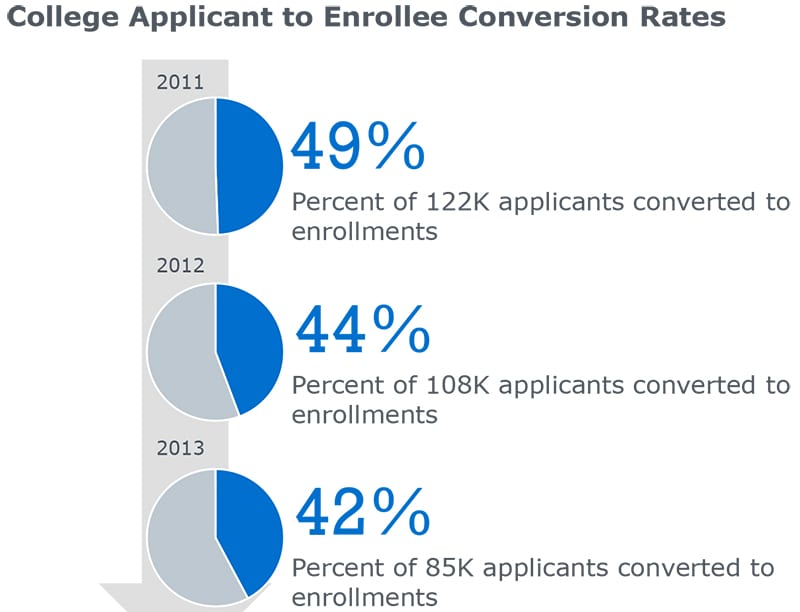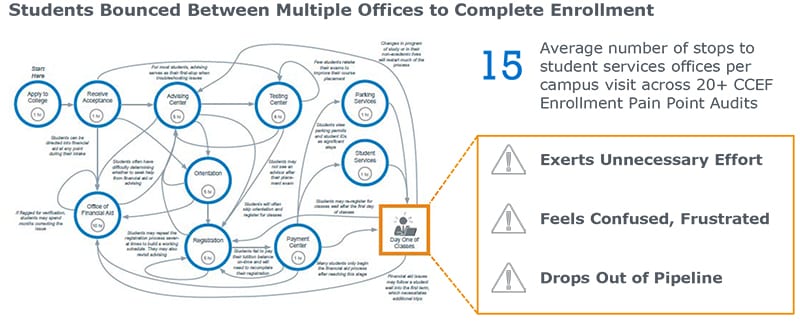To Boost Enrollment Quickly, Focus on Reducing the Effort Required to Enroll
Reversing 7% drop in applicant conversion rate would create more than $2M in tuition revenue
Losing students before they start
Community colleges are seeing alarming increases in students who apply to the institution but drop out before attending their first class. Between 2011 and 2013, the percentage of applicants who completed their enrollments fell by 7%.

Heading off this early attrition not only helps more students achieve their goals; it is also one of the fastest routes to boosting enrollment. At a mid-sized community college receiving 12,000 applications, raising the applicant conversion rate back up to the 2011 average of 49% would produce close to $3 million in additional tuition revenue.

Don’t just improve “customer service”
Many colleges have tried to improve their student intake process by providing their staff with the kind of customer service training used extensively in the private sector. With methods pioneered by companies such as Disney, these initiatives train staff to be polite, express concern, and listen carefully. They don’t, however, address the fundamental problem: the amount of effort it takes students to enroll.
While college staff often see the intake process as a linear path from application to matriculation, students report widespread frustration with the time and effort required to figure out and complete all the steps for enrollment. We interviewed dozens of students who described confusion about the sequence and number of enrollment steps, difficulty locating buildings and offices, long wait periods to advance from one step to the next, confusing websites, confusing terminology, no guidance on how to get questions answered, and being shuffled from one department to the next for answers to inquiries.
Check Out Our Infographic on New Student Intake
Across 2014, members of our research team visited more than 20 community colleges in the role of potential students to study these problems first hand. Adopting student personas and knowledge, we spent one full day on each campus attempting to complete as many enrollment steps as possible. We experienced all the frustrations students had described to us. At each campus, we had to make an average of 15 stops at offices for student services.

Low-cost, high-impact practices
Along with experiencing enrollment first hand as “secret shoppers,” our researchers spent the last year surfacing innovative practices that reduce applicants’ effort and help them maintain momentum across the enrollment process.
One of the most impactful is immediate ID provision. At most colleges, students must wait at least 24 to 48 hours to receive the ID number needed to complete other enrollment steps. After arriving on your campus with the intention of enrolling, they have to leave with this task unfinished and return another day. For students with harried lives, transportation challenges, or wavering confidence, that return visit may never happen.
Laredo Community College has removed that barrier to enrollment. Any student who submits an application, whether on paper on online, is issued an ID number within minutes so they can proceed with enrollment immediately.
Initially, many staff at Laredo feared that the new policy would result in too many students missing high school transcripts, proof of residency, or other important documentation. But across the thousands of students admitted, Laredo found that fewer than 3% of all applications had omissions requiring follow up. Students who were missing paperwork brought it back, so the college was complying with all state regulations as well, but on students’ timelines, not administrators.
This resource requires EAB partnership access to view.
Access the research report
Learn how you can get access to this resource as well as hands-on support from our experts through Strategic Advisory Services for Community Colleges.
Learn More